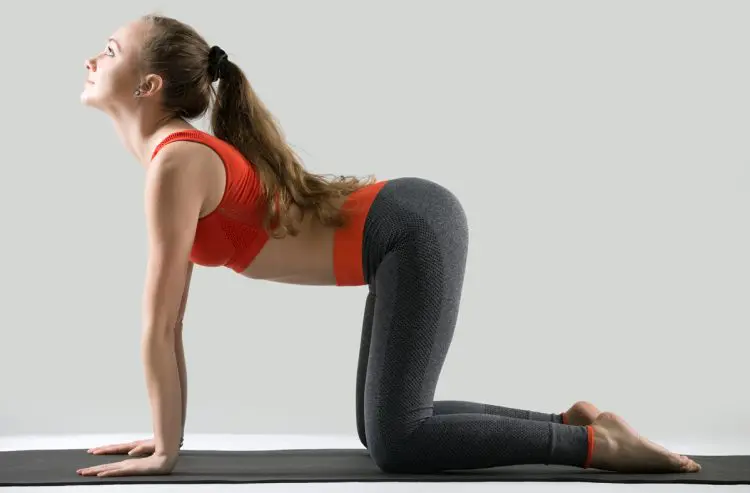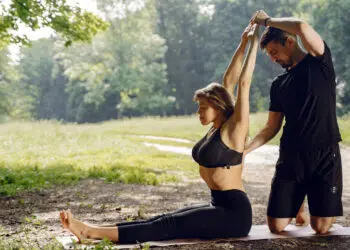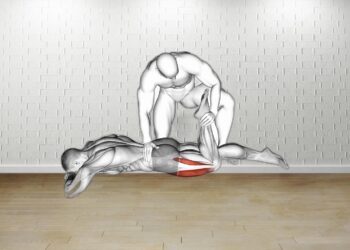A quick internet search for “best back stretches” shows how biased we are towards issues more specifically related to the lower back, and justifiably so as it’s a common problem area for many. But you should be just as concerned about the middle and upper back, especially if you’re a serious lifter, value physical performance, and good posture, and plan to maintain healthy movement patterns well into your later years.
Both my credentials and content require a proper understanding of human anatomy and movement, not to mention, I’ve felt firsthand the consequences of not having a balanced fitness and physical maintenance routine. And that manifests itself in the form of pains, asymmetries, limited mobility, and worse problems down the line.
The fixed bar back stretch is in a class of muscle elasticity variations that thoroughly hits the all-important central and upper backside, unlike the common lat-focused bar dead hangs, seated twists, and toe touches for back flexibility. And if you’re not utilizing it or similar alternatives, then we urge you to start now for the reasons mentioned above and later on.
Don’t have access to the required setup for the fixed bar back stretch? No need to stress (You’ll cause more back tightness), we’ve also chosen and demonstrated the best variations and alternatives for that often untouched region between the shoulder blades.
Let’s catapult into this in-depth posterior stretching guide.
Please note: The following information is not medical advice and should not be used as a replacement for proper health evaluation, or to diagnose concerning physical ailments. However, the stretching exercise offered in this training guide can be a beneficial addition to your weekly activities for reasons covered in this guide.
Level Up Your Fitness: Join our 💪 strong community in Fitness Volt Newsletter. Get daily inspiration, expert-backed workouts, nutrition tips, the latest in strength sports, and the support you need to reach your goals. Subscribe for free!
How To Do The Fixed Bar Back Stretch
For this exercise, you’ll need to find a sturdy, fixed bar like that built into an exercise rack, for example. But feel free to use any setup that can safely support your weight. Learn the fixed bar back stretch in just a few steps using the instructions provided below, and check out the video demonstrations as well.
Steps
- While standing fully upright, grip the bar in front of you with one hand somewhere between belly button and lower chest height.
- Then bend your hips and knees slightly to a quarter squat position.
- Now shift your weight rearward, allow your arms to protract all the way forward, and create rounding in the upper back to allow a full stretch in the middle and top portions.
- Hold the stretch for 10 seconds, return to the starting position, and repeat this sequence two more times. Or, you can alternate arms for each set (E.g., stretch the left side, then immediately change arms and repeat on the right side).
Make sure to complete the same number of sets with both arms.
Pro Tips
- Try using a reverse grip, you may feel a more pronounced stretch in the back muscles.
- If you feel constant pain or severe back tightness, we recommend consulting a medical professional who can assess, guide, and apply the most optimal stretching strategies to improve your condition in a safe and progressive manner.
- Rounding your upper back is good in this case as it will allow you to get the best stretch in the middle and upper back region.
Muscles Affected By The Fixed Bar Back Stretch
Back muscles – Due to the middle and upper back-focused nature of fixed bar back stretches, you’ll feel more muscle opening action in the latissimus dorsi, rhomboids, infraspinatus, trapezius, and the whole scapular department.
These muscles operate the backside of the body between the neck and waist, allowing arm and torso movement in various directions.
In the fixed bar back stretch, we want to protract the arms forward to unlock the traps and move them out of the way to free up the scapula and experience full mid back stretching effects.
Rear delts – Shoulders are a tri-headed muscle complex that moves the arm relative the the placement of its fibers. For example, the front-facing head brings the arms forward, while the lateral muscle lifts it outward, and posterior or rear delt fibers pull the arms behind you.
The fixed bar back stretch simply helps to creat e healthier functional environment for the rear delts.
Biceps brachialis, and forearms – Gripping and pulling on a fixed object also stretches the anterior upper arm biceps muscles, as well as the ones that pass through the below like the brachioradialis that flexes the arm.
Benefits of The Fixed Bar Back Stretch
The advantages of a fixed bar back stretch go much further than what its name suggests. These are the unique benefits of spinning the fixed bar back stretch into your posterior exercise rotation.
Flush tension from your upper posterior
Since many of our readers are lifters, and very active individuals, fixed bar back stretches or similar variations are going to be an unparalleled option to include in your stretching regime.
Deadlifts, rows, and intense back training programs will build the upper rear posterior of your dreams, but they also require the same recovery and maintainance efforts to keep the muscles and your movement in tip top shape.
All that lifting often causes tightness between the paraspinal muscles and scapula. But then far too many exercisers forego stretching or only do it once in a while haphazardly. You can’t lift hard and often and not neglect what your muscles need. Like you can’t have your cake and eat it too.
Then you also have other non-lifting related physical and mental stress that oftentimes manifests itself in your shoulders, neck, upper posterior, and even head. It can be due to bad habits, movements, or injuries, but also anxiety and psychological factors that can cause you to tense up, even if you don’t realize it.
Secure your range of motion and future
Tight or shortened muscles limit your ability to move body parts most optimally, and hence safely. They can pull your joints out of alignment, cause uneven movement patterns, and consequently cause sudden injuries when the fibers, joints, etc, lack ideal elasticity relative to your desired activities. In fact, limited motion is a common cause of physical traumas.
But tense musculature can be due to lack of activity (You’re out of shape), poor habits, lots of activity (Overuse), injuries, and both physical and emotional stress.
But it’s important to note that if you truly have tight muscles, you’ll need to baby them through progression, not rushing to restore their full length.
Promote symmetrical movement
Your daily habits from how you sit to how you sleep, walk, train, and even work can affect muscle function and symmetry. But this is especially true the older you get, and limping starts to become more common after those long sitting marathons. Muscle underuse, overuse, and injuries go hand in hand, and are culprits for left to right, and front to back body imbalances.
These weaknesses are even more apparent when you start exercising, and noticing those caving knees, uneven pulling, awkward movements, pains, and lack of stability.
Common Mistakes
While it’s simple enough to be suitable for beginners, you still need to understand the basic mechanics of a good back stretch. Here’s some technique advice and things to avoid in the fixed bar back stretch.
Doing a lat-focused stretch
While we want you to hit the lats too, we don’t want it to be the main focus. By grabbing the bar too high, and sitting down into the stretch, we really focus on the lats, and shift away from the rhomboids and traps. You want to keep the arms torso height and sink back to effectively target the larger middle back and scap muscles.
Keeping your shoulders retracted
When it comes to resistance training, retracting the shoulders is ideal as it stabilizes, and promotes optimal muscle activation, movement, efficiency, strength, and power. Not just in the primary target muscles but also the surrounding and assisting muscle groups as well.
Level Up Your Fitness: Join our 💪 strong community in Fitness Volt Newsletter. Get daily inspiration, expert-backed workouts, nutrition tips, the latest in strength sports, and the support you need to reach your goals. Subscribe for free!
But you cannot fully stretch the back if your shoulder blades are pulled back or even partially retracted as it restricts your ability to fully lengthen the muscle fibers.
Pulling too intensely
Don’t start right out of the gate by pulling as hard as you can. Be mindful that your shoulder and scapula are involved and they can be compromised if stretched too aggressively. That’s why I may hesitate to recommend this one for beginners or those without basic knowledge of body safety.
Go very slow, avoid leaning all your weight back just yet, and try to feel what’s going on in the affected muscles. From here, you can adjust your body position to hit the desired parts of your posterior.
Bouncing
The nature of fixed bar back stretches presents an optimal opportunity to use momentum. But you won’t find this suggestion anywhere in our instruction manual here. Bouncing or rocking can pull a muscle, stretch it too much, and bouncing can be counterintuitive as this ballistic action can tighten the muscle as a protective reaction.
Instead focus on static, progressive stretching where you sit in a pose and let the muscles loosen naturally.
4 Variations and Alternatives
When it comes to back stretches, anything goes in choosing the best variations and alternatives. The back is probably one of the most understretched muscles of the body along with the glutes, and hamstrings, simply because they’re hidden and out of plain sight.
So there may be a natural propensity to primarily stretch the muscles you can see in the mirror (e.g., chest, biceps, quads). But even when people think they’re getting a good back stretch, they’re only really just scratching the surface.
We want to give you many reasons to stretch your upper posterior more and here are the only three middle and upper back stretches you’ll ever need!
Cross arm/doorway stretch
More practical than the fixed bar back stretch is to use a doorway in its place. Most people can easily access a door frame, where they may not have a stable bar available, although you may utilize a suitable alternative too.
Now, there is a secret to the door stretch but it’s simple, cross your arms and grab the door frame with the opposite side hands.
For example, if you’re standing between the doorway, reach your right arm to the left side of your body and grab the left side of the door frame. Then cross left arm over right, and grab the right side of the door. You’re going to notice how much more you feel the stretch especially in the center of the back.
Whereas if you do this same stretch with your arms not crossed, you’ll feel more emphasis on the outer portion of your back.
Pro tip: A cable crossover machine makes for a great gym alternative to the doorway stretch. You’re also not locked in place like with a door frame, so it may be more comfortable as you can move more freely.
Here’s an excellent video demonstration of the cross arm back stretch, presented by world famous trainer Jeff Cavaliere, MS PT, CSCS, and founder of the ultra-popular Athlean X YouTube channel.
Kneeling back stretch
A more lat-centric but full back stretch technique that you’ll feel in the rhomboids and even down to the tailbone, this kneeling variation utilizes your own body weight to push deeper into the lengthening phase. Imagine stretching a rubberband, and that’s kind of what you’re doing in this child’s pose stretch variation.
You’ll need something like a training bench or chair height object with a cushioned top as you’ll be leaning onto it with your elbows.
To do it:
- Start from a tall kneeling position on a soft surface or mat facing your object (Chair, bench, bed, etc).
- Then bend your arms at a 90-degree angle, then gently lean your upper body forward onto the object with the back of your upper arms and elbows. Your upper legs should be mostly vertical with the hips over your knees.
- From here, reach your fingers back and touch the top of your shoulders, then try to reach with your fingers as far down on your upper back as possible. Tuck your chin down into your chest.
- Now slowly and gradually push your butt down to create the stretch effect, then stop when you feel a decent stretch and don’t overdo it.
- Lift your butt toward the platform to reset, then repeat this process 3-5 more times, for roughly 10-30 seconds per stretch.
Pro tip: Do not try to sit down too fast or too much as you can do damage to the muscles if they’re not used to stretching.
Child’s pose thread the needle stretch
This movement combines the yoga-based child’s pose with a rotational element, aka threading the needle for a monstrous full back stretch. And what’s lovely about this technique is that it can help strengthen the arms and wrists while training your balance.
So it’s suitable for beginners, elderly exercisers, and anyone in between who wants to wake up their back muscles. You can’t do this stretch right from your bed.
To do it:
- Begin on your hands and knees in an all fours position on a comfortable surface. Move your hands slightly forward so they’re not directly below but slightly past the shoulders.
- Tuck your chin into your chest, then shift your butt back towards your heels.
- Then lift one arm off, bend it 90 degrees with palm facing up toward the ceiling, then move the arm under and push it through to the opposite side (Threading the needle). You should be able to twist your body and feel a lovely stretch in your rear torso.
- Hold for 15-30 seconds.
- Return to the starting pose with both hands down, then lift the opposite arm and repeat the technique for the same duration.
- Perform the stretch two to three times per side.
Pro tip: Start with less trunk rotation then increase it for the subsequent sets or workout sessions, as your flexibility and comfort allow.
Cat-cow pose

A fundamental yoga pose, and alternative to the fixed bar back stretch, cat-cow pose targets the same muscles but without the same potential level of intensity as there’s no anchor point to leverage your body weight. The combination of cat and cow create both spine flexion and extension.
Plus you can work on breathing during your movements which is an added benefit of yoga technique.
If you normally do yoga, then it’s a no-brainer, but it’s a good general back stretch with added benefits for everyone else.
To do it:
- Start the pose from your hands and knees on all fours with the arms vertical, wrists under shoulders, and knees under the hips. Maintain a neutral back, and curl your toes under.
- For cow, inhale, tilt the pelvis back, lift your butt, drop your belly, then gently extend the neck up and gaze toward the ceiling.
- For cat, uncurl the toes, exhale, pull your belly button toward the sky, round your spine, and relax your head toward the floor. Simultaneously press your hands into the floor to deepen the stretch.
- Inhale then move into the cow pose.
- For each breath, alternate between cat and cow pose.
Note: You can also do this pose seated or standing if you have joint pain in the all fours version. Additionally, if you have neck issues, keep it neutral during the exercise.
FAQ’s
How long should I hold the stretch position for best results?
Unlike the two arm version, you want to make sure you’re stretching for an equal count on both your left and right sides. Therefore, it’s more important to keep track of the time holding your stretches to avoid uneven results.
As for the specific number, 10-15 seconds is sufficient time to achieve a nice stretch in your back. Then you should repeat two to three more times.
How often should I be stretching my back?
That depends on how much you can benefit from stretching. Some people may need it more often than others due to their daily habits, physical condition, and degree or severity of their back tightness.
However, in general, the American College of Sports Medicine recommends stretching your muscles at least two to three times per week (1).
Is the fixed bar back stretch safe for everyone?
While the fixed bar back stretch is generally safe to do, we recommend avoiding it if you’re experiencing severe or uncertain pain in your upper back, neck, or shoulders as it could make the problem worse.
It’s better to consult with a qualified medical professional who is qualified to properly diagnose, and help treat your condition.
Wrapping Up
The fixed bar back stretch and its variations fill a specific niche that not even bar hangs, or other common back stretches can access. If you want to wake up your mid-upper back muscles, test their lengthening limits, and have that translate to your big lifts, and daily life, then there really aren’t any alternatives to gripping something in front of you and dropping your weight straight back.
You’ll also need to let go of the shoulder retraction cue as it does not apply here. Protraction or a fully forward arm position is the secret code to reaching those deep posterior fibers.
But again, if you don’t have a fixed bar, well you could use any similar object, or go with one of the variations or alternatives we also included here.









